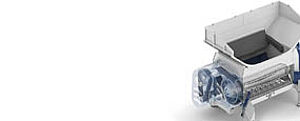LINDNER POLARIS HAS THE BEST PERFORMANCE
‘We are happy across the board.’ In this interview Joachim Wunsch, the busy Operational Excellence Manager at ALBA Nordbaden, talks about how the Polaris 2800 single-shaft shredder from Lindner Recyclingtech became the centrepiece of the company’s new RDF plant in Karlsruhe, Germany.
The key aspects: availability, throughput capacity and grain size. Yet it was the performance demonstration by the Austrian machine manufacturer on site that convinced the certified waste management company with 230 employees to award Lindner the contract. According to the requirements listed in the call for projects by the ALBA group’s sister company, the desired shredder should be able to shred 20 tons of input material per hour. The Polaris 2800 exceeded these specifications by over 15% or more than 23 tons. Lindner’s machine simply outperformed its competitors. Within three days the steadily running system was integrated into the new RDF plant of ALBA Nordbaden.
Mr Wunsch, on 11th April 2017 ALBA Nordbaden’s new RDF plant opened in Karlsruhe. CEO Robert Kassel welcomed numerous representatives from the fields of politics, business and industry to the Werk II factory for its inauguration. Afterwards, the new RDF plant was shown in operation. What was your experience of that afternoon – in particular in terms of the technology demonstration?
Joachim Wunsch: It was a great pleasure and very reassuring that so many guests accepted our invitation, especially Thomas Strobl, the Deputy Minister-President of Baden-Württemberg, and Klaus Stapf, the Mayor of Karlsruhe. When you have worked so long on a project, it makes you feel very proud when you can finally present it and everything runs smoothly.
The new RDF plant was constructed within only four months. Why did you start the project and how was it implemented?
J.W.: Our former plant was quite old, not state of the art and the latest Commercial Waste Ordinance was about to take effect this year. That’s why we decided to construct a new plant that would already conform to the latest Commercial Waste Ordinance. It is thanks to all the project participants that we were able to construct it that fast.
What’s the difference between this plant and other (older) solutions on the market?
J.W.: The new plant makes it possible for the first time to shred waste to a grain size of 80 millimetres in one single step. In a fully automated process, the over-belt magnet and the near-infrared technology remove recyclable material such as plastics, ferrous and non-ferrous metals from the material flow. Components containing chlorine are also eliminated during the separation, resulting in high-quality RDF.
Does the plant run in shifts (24/7)? How many workers do you need for each task?
J.W.: At the moment, we run the plant with three to four workers, ten hours a day. We are thinking of switching to round-the-clock multi-shift operation. However, it depends on the output contingencies.
The plant can process up to 40,000 tons of waste a year (input amount). Where you get the material for your RDF, what kind of waste is it and what is it made up of?
J.W.: With the new plant, we mainly process construction and commercial waste. The material is shipped from the Greater Baden area and comes from commercial and industrial operations, from demolition work and smaller craft workshops. Our refuse-derived fuel which we produce from the waste is then used in power and cement works as a substitute for fossil fuels. We produce around 33,000 metric tons of RDF per year, which corresponds to the annual power consumption of 41,000 two-person households.
What calorific properties does the final product have and who buys it?
J.W.: We produce material with a medium calorific value of 17 to 18 megajoules. The RDF are used in power and cement works in the region.
What do you do with the foreign objects and non-recyclable residual material separated in the process?
J. W.: Recyclable materials such as metal are recycled and non-recyclable material is thermally recovered.
Let’s talk about Lindner-Recyclingtech: in the new RDF plant you use a Polaris 2800 shredder by the Austrian manufacturer. How did you find out about Lindner and why did you decide to use this particular type of machine?
J. W.: With a demonstration right here in Karlsruhe, Lindner was able to convince us that their machine could give us what we wanted: the right grain size (smaller than 80 millimetres) and the desired throughput.
What requirements did Lindner meet that led to you awarding them the contract?
J. W.: The following three key aspects that Lindner fulfilled were important to us: availability, throughput and grain size.
What has been your experience of the Polaris 2800 in terms of shredding performance, throughput, capacity, efficiency, reliability, operability, energy consumption, maintenance, wear and tear, fault repair, technical support and service etc. so far?
J. W.: We have not been working with the machine that long, but we are happy across the board, especially with the low energy consumption, the input capacity and the throughput. Also the operability, the fault repair and the technical support have all completely met our expectations.
The input material is shredded to less than 80 millimetres. How does the machine react to coarse foreign objects and obstructions in the material flow?
J. W.: Through the foreign parts door, foreign objects and obstructions can be removed relatively quickly. It takes a maximum of five minutes, meaning that most of the time it’s not really relevant since operations can be resumed almost immediately.
Have you already changed the knives or any other parts? In principle, is it possible for your workers to maintain the machine by themselves?
J. W.: In general we change the knives ourselves. The knives on the counter comb are first mounted by us on a second set of slides, meaning they can be replaced quickly. The other knives can be used three to four times before we change them.
And finally, a question about developments on the RDF market. The UK is a leading export player and sends lots of waste to Germany and continental Europe for energy recovery. What impact will the UK’s withdrawal from the European Union have on the RDF business?
J. W.: First the UK’s withdrawal has to be completed and then we will have to wait and see what real consequences this Brexit will have. Everything is still up in the air at the moment.

